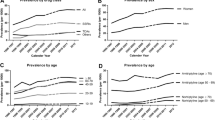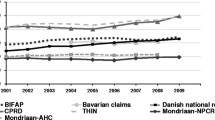Abstract
Background
Italy is reported to have a relatively low consumption of antidepressants. This is probably due to the fact that until 2000 antidepressants were reimbursed with some restrictions.
Aim
To describe the pattern of use of antidepressants in primary care in Italy, after admission of selective serotonin reuptake inhibitors (SSRIs) for reimbursement without restrictions.
Methods
We collected prescription data of antidepressants (ATC code: N06) reimbursed between January 1999 and March 2002 from three local health authorities in Emilia Romagna. Then, we calculated the prevalence of use for the different therapeutic classes of antidepressants, by age and gender. Moreover, after selecting a cohort of incident adult patients to follow for 6 months after the first prescription, we analysed the continuity, the average daily doses and the average duration of treatment.
Results
Out of 1000 subjects, 78 received at least one prescription of antidepressants in 1 year. The prevalence of use increased with age from 43 to 136/1000. Women used antidepressants more frequently than men, with a ratio varying from 1.6 to 2, depending on age. SSRIs were the most used drugs (63%), and their prevalence of use diminished with age; on the contrary, use of mianserine and trazodone increased with age, and that of the other antidepressants did not vary. About 60% of the subjects received occasional prescriptions. Continuous treatment was more frequent with SSRIs and in subjects older than 34 years. Daily doses were higher in patients receiving newer drugs (0.9–1 DDD per day), and lower in patients receiving the older agents (0.3–0.4 DDD per day). The average daily doses were usually lower than those recommended for the treatment of the major depression, especially for tricyclics, trazodone and reboxetine. Overall, doses were within the recommended range in about 75% of recipients of newer antidepressants (i.e., SSRIs, venlafaxine, mirtazapine and reboxetine), and in less than 30% of recipients of older drugs (i.e., tricyclics, trazodone and mianserine). In 59% of subjects receiving continuous treatment, the duration of the therapeutic course was at least 6 months.
Conclusions
We found a high prevalence of use of antidepressants in primary care with a frequency of occasional use higher than in other countries. Only rarely were doses and duration of treatment consistent with recommendations for treatment of depression. Recipients of newer drugs received doses consistent with a use for major depression more frequently than others; however, rates of 6 month duration did not differ among drug classes.


Similar content being viewed by others
References
Donoghue J, Hylan TR (2001) Antidepressant use in clinical practice: efficacy v. effectiveness. Br J Psychiatry Suppl 42:S9–S17
McManus P, Mant A, Mitchell PB, Montgomery WS, Marley J, Auland ME (2000) Recent trends in the use of antidepressant drugs in Australia, 1990–1998. Med J Aust 173:458–461
Osseratorio nazionale sull’impiego dei medicinali (2002) L’uso dei farmaci in Italia—rapporto nazionale anno 2001
Pietraru C, Barbui C, Poggio L, Tognoni G (2001) Antidepressant drug prescribing in Italy, 2000: analysis of a general practice database. Eur J Clin Pharmacol 57:605–609
Whooley MA, Simon GE (2000) Managing depression in medical outpatients. N Engl J Med 343:1942–1950
Anderson IM, Nutt DJ, Deakin JF (2000) Evidence-based guidelines for treating depressive disorders with antidepressants: a revision of the 1993 British Association for Psychopharmacology guidelines. British Association for Psychopharmacology. J Psychopharmacol 14:3–20
Anonymous (2000) Practice guideline for the treatment of patients with major depressive disorder (revision). American Psychiatric Association. Am J Psychiatry 157:1–45
Simon GE (2002) Evidence review: efficacy and effectiveness of antidepressant treatment in primary care. Gen Hosp Psychiatry 24:213–224
Montanaro N, Vaccheri A, Magrini N, Battilana M (1992) FARMAGUIDA: a databank for the analysis of the Italian drug market and drug utilization in general practice. Eur J Clin Pharmacol 42:395–399
WHO Collaborating Centre for Drug Statistics Methodology (Norway) (2000) ATC index with DDDs
Anonymous (2002) Web site of the Regional Government of Emilia Romagna by January 2003:http://www.regione.emilia-romagna.it/sas/statistica/
Rosholm JU, Gram LF, Isacsson G, Hallas J, Bergman U (1997) Changes in the pattern of antidepressant use upon the introduction of the new antidepressants: a prescription database study. Eur J Clin Pharmacol 52:205–209
Williams JWJ, Mulrow CD, Chiquette E, Noel PH, Aguilar C, Cornell J (2000) A systematic review of newer pharmacotherapies for depression in adults: evidence report summary. Ann Intern Med 132:743–756
Tansella, M De Girolamo G (2001) Il ruolo del medico in medicina generale. In: Salute mentale: contro il pregiudizio, il coraggio delle cure.http://www.salutementale-oms.it/Medico.htm
Arpino C, Da Cas R, Donini G, Pasquini P, Raschetti R, Traversa G (1995) Use and misuse of antidepressant drugs in a random sample of the population of Rome, Italy. Acta Psychiatr Scand 92:7–9
Isacsson G, Boethius G, Henriksson S, Jones JK, Bergman U (1999) Selective serotonin reuptake inhibitors have broadened the utilisation of antidepressant treatment in accordance with recommendations. Findings from a Swedish prescription database. J Affect Disord 53:15–22
Rosholm JU, Andersen M, Gram LF (2001) Are there differences in the use of selective serotonin reuptake inhibitors and tricyclic antidepressants( A prescription database study. Eur J Clin Pharmacol 56:923–929
MacDonald TM, McMahon AD, Reid IC, Fenton GW, McDevitt DG (1996) Antidepressant drug use in primary care: a record linkage study in Tayside, Scotland. BMJ 313:860–861
MacDonald TM, Reid IC, McMahon AD (1997) Patients receive an inadequate dose of antidepressants for an inadequate period. BMJ 315:56
Dunn RL, Donoghue JM, Ozminkowski RJ, Stephenson D, Hylan TR (1999) Longitudinal patterns of antidepressant prescribing in primary care in the UK: comparison with treatment guidelines. J Psychopharmacol 13:136–143
Furukawa TA, McGuire H, Barbui C (2002) Meta-analysis of effects and side effects of low dosage tricyclic antidepressants in depression: systematic review. BMJ 325:991
Lawrenson RA, Tyrer F, Newson RB, Farmer RD (2000) The treatment of depression in UK general practice: selective serotonin reuptake inhibitors and tricyclic antidepressants compared. J Affect Disord 59:149–157
McManus P, Mant A, Mitchell P, Britt H, Dudley J (2003) Use of antidepressants by general practitioners and psychiatrists in Australia. Aust N Z J Psychiatry 37:184–189
Gilsa HD, Sondergaard J, Vach W, Freng GL, Rosholm JU, Kragstrup J (2003) Antidepressant drug use in general practice: inter-practice variation and association with practice characteristics. Eur J Clin Pharmacol 59:143–149
Acknowledgements
The study was supported by grants from the Regione Emilia Romagna Health Authority. For supplying prescribing data, the authors wish to thank the pharmacists of participating local health authorities: Francesco Pacella, Maria Vittoria Novi, Marco Manzoli and Mirna Magnani. We also thank Mr. Roberto Da Cas (OsMed, Rome) for kindly supplying data of other Italian regions.
Author information
Authors and Affiliations
Corresponding author
Rights and permissions
About this article
Cite this article
Poluzzi, E., Motola, D., Silvani, C. et al. Prescriptions of antidepressants in primary care in Italy: pattern of use after admission of selective serotonin reuptake inhibitors for reimbursement. Eur J Clin Pharmacol 59, 825–831 (2004). https://doi.org/10.1007/s00228-003-0692-1
Received:
Accepted:
Published:
Issue Date:
DOI: https://doi.org/10.1007/s00228-003-0692-1




